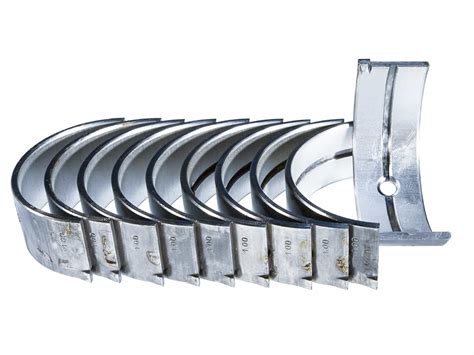The Unsung Heroes of Engine Performance: A Comprehensive Guide to Engine Bearings
Engine bearings, the unsung heroes of every internal combustion engine, are the linchpins of a well-functioning engine. These precision-engineered components play a critical role in reducing friction, ensuring proper lubrication, and maintaining crankshaft alignment, ultimately extending the longevity and efficiency of the engine.
Understanding Engine Bearings: Function and Significance
Engine bearings are thin, precision-made components typically made of steel or aluminum and lined with a bearing material, such as copper-lead or tin-aluminum. These bearings are positioned between the crankshaft and the connecting rods, providing a smooth surface for the crankshaft to rotate.
Their primary function is to reduce friction by providing a low-resistance surface for the crankshaft to rotate upon. Friction can generate excessive heat and wear, leading to premature engine failure. Engine bearings also ensure proper lubrication by distributing oil throughout the engine and preventing metal-to-metal contact between the crankshaft and connecting rods.

Types of Engine Bearings
There are various types of engine bearings, each designed for a specific purpose and engine application. Some common types include:

-
Main bearings: Support the crankshaft at various points along its length, maintaining its alignment and preventing excessive movement.
-
Connecting rod bearings: Connect the connecting rods to the crankshaft, allowing for smooth rotation and precise piston movement.
-
Cam bearings: Support the camshaft, which controls the timing of the engine valves.
-
Thrust bearings: Control the axial movement of the crankshaft, preventing excessive end-play and maintaining crankshaft alignment.
Material Composition and Manufacturing Process
Engine bearings are typically manufactured using a combination of steel or aluminum for the backing material and a bearing material for the lining. The backing material provides structural support and durability, while the bearing material ensures low friction and wear resistance.
The manufacturing process involves several precision steps, including:
-
Forging or casting: The backing material is shaped into the desired bearing form.
-
Machining: The bearing is machined to precise dimensions, ensuring a perfect fit within the engine.
-
Coating: A thin layer of bearing material is applied to the surface of the backing material.
-
Finishing: Final machining and polishing are performed to achieve the desired surface finish and dimensional accuracy.
Importance of Proper Lubrication and Maintenance
Proper lubrication is crucial for the longevity and performance of engine bearings. Engine oil provides a lubricating film between the bearings and the crankshaft, reducing friction and preventing wear. Regular oil changes and filter replacements are essential to maintain clean oil and prevent contamination.

Inadequate lubrication or clogged oil filters can lead to bearing failure, resulting in catastrophic engine damage.
Common Mistakes to Avoid
-
Overtightening bearings: Exceeding the torque specifications during bearing installation can damage the bearing and affect its performance.
-
Using incorrect bearing clearances: Insufficient or excessive clearance can lead to premature wear, noise, or seizure.
-
Failure to replace bearings during engine rebuilds: Bearings have a finite lifespan and should be replaced during major engine overhauls.
-
Ignoring warning signs: Unusual noises, excessive vibrations, or oil leaks can indicate bearing problems and should be addressed promptly.
Potential Drawbacks
Despite their crucial role, engine bearings have certain drawbacks:

-
Cost: Engine bearings can be expensive to replace, especially for high-performance engines.
-
Complexity: Bearing replacement often requires significant disassembly of the engine, increasing labor costs.
-
Wear and tear: Engine bearings are subject to wear and tear over time, necessitating periodic replacement.
Interesting Stories
1. The Overzealous Mechanic
A mechanic, eager to prove his expertise, overtightened the engine bearings during installation. As a result, the bearings seized, causing catastrophic engine damage and a costly repair bill for the unlucky customer.
Lesson learned: Follow torque specifications and avoid overtightening bearings.
2. The Forgetful Driver
A driver neglected to change the engine oil regularly, leading to sludge buildup and clogged oil filters. Lack of lubrication resulted in bearing failure and extensive engine damage.
Lesson learned: Regular oil changes and filter replacements are essential for bearing longevity.
3. The Ignored Warning Signs
A driver ignored the warning signs of bearing failure, such as unusual noises and oil leaks. As a result, the bearings seized, causing the engine to lock up and require a complete rebuild.
Lesson learned: Pay attention to warning signs and address bearing issues promptly to prevent catastrophic engine damage.
FAQs
1. How often should engine bearings be replaced?
Engine bearing replacement intervals vary depending on the engine type and operating conditions. Consult your vehicle's owner's manual or a qualified mechanic for specific recommendations.
2. What are the symptoms of worn engine bearings?
Symptoms of worn engine bearings can include:
- Unusual noises (knocking, ticking, or grinding)
- Excessive vibrations
- Oil leaks
- Reduced engine power
- Increased oil consumption
3. Can I replace engine bearings myself?
Bearing replacement is a complex task that requires specialized tools and knowledge. It is recommended to consult a qualified mechanic for proper installation and to avoid potential engine damage.
